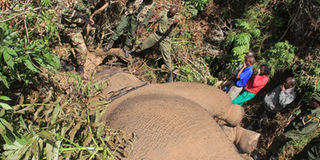Elephant that symbolised Kenya’s wildlife conservation campaign found dead at 46

PHOTO | JOSEPH KANYI Game wardens from Lewa Conservancy in Laikipia inspect “Mountain Bull’s” carcass after it was killed by poachers in Mt Kenya Forest and its tusks hewn off.
What you need to know:
- Animal brought attention and efforts towards human-wildlife conflict in the country
- The enigmatic bull is described by conservationists at Lewa Wildlife Conservancy in Isiolo County as an animal whose dedication to using the traditional elephant migratory route in northern Kenya captured the imagination of many and led to numerous conservation initiatives.
Wildlife lovers are mourning the death of an elephant nicknamed “Mountain Bull” that was killed by poachers last week.
The enigmatic bull is described by conservationists at Lewa Wildlife Conservancy in Isiolo County as an animal whose dedication to using the traditional elephant migratory route in northern Kenya captured the imagination of many and led to numerous conservation initiatives.
But to those who had settled along the elephant’s migratory route – or those neighbouring the Lewa Wildlife Conservancy – the 46-year-old elephant was nothing but big trouble.
During the dry season, the six tonne beast would often retreat to the cool and quiet Mount Kenya forest, while in the wet season he would be active in exploring the expansive countryside in the north, knocking down any fences he came across and eating his fill of farmers’ crops.
Conservationists say “Mountain Bull” was often involved in cases of human-elephant conflict, opening gates and raiding farms that lie on these elephant routes. This way, it highlighted the issue of human-wildlife conflict in the country and enabled them to develop mitigation strategies.
This led to the legendary elephant’s tusks being trimmed in October 2012 at the neighbouring Borana Conservancy. With shorter tusks, “Mountain Bull” found it more difficult to snap fence wires and raid farms.
Besides, wildlife conservationists expected that the trimming of the tusks would make the animal less attractive to poachers.
“Mountain Bull” had been fitted with a GPS-GSM collar by Save the Elephants, a non-profit organisation, enabling him to be tracked as he traversed Samburu, Lewa, Ngare Ndare and Mount Kenya forest ecosystems.
But early last week, Lewa Wildlife Conservancy co-founder Ian Craig noticed that the elephant had been immobile; its collar had not emitted any signal from the last reported position in Mount Kenya forest.
This raised the alarm and a search team from Lewa Wildlife Conservancy and the Mount Kenya Trust, an organisation dedicated to helping preserve and protect Mount Kenya, was launched.
“Mountain Bull’s” carcass was found in the thick Mt Kenya forest at around 4.30 pm on Thursday having spear wounds and missing tusks. It is suspected that the elephant had been poached eight days before the find.
According to the Lewa Wildlife Conservancy, no other animal had had greater impact on wildlife conservation in northern Kenya than “Mountain Bull”. Many credit the elephant for being the force behind the construction of the pioneering elephant corridor stretching from Mount Kenya through Lewa and onwards north into the wide expanse of Samburu, connecting Lewa Wildlife Conservancy and the Ngare Ndare Forest Trust to Mt Kenya.
Lewa Chief Conservation Officer Geoffrey Chege says this has led to the opening up of the traditional migratory route of over 2,000 African elephants that had previously been blocked by human development in Mt Kenya.
“‘Mountain Bull’ has been following those migratory routes, of which one comes from Lewa into Mt Kenya and then back, and used to break through fences that separate the two landscapes and this one brought like-minded personalities and conservationists in Kenya with an intention of establishing at least a safe corridor that was to be used by the elephants in moving between Samburu and Mount Kenya forest,” he says.
The corridor is estimated to be approximately 10 km long and it has an electric fence on both sides so that elephants can be funnelled when they are coming from Lewa to Mountt Kenya forest and vice-versa.
“Elephants have got very good memory and they always follow their traditional migratory routes. Historically, elephants used to migrate all the way from northern Kenya and then Mount Kenya into Laikipia, then back through the same route,” Mr Chege observes.
He says that due to significant human development, most of the migratory routes have been blocked by development and related infrastructures.
The elephant corridor linking Lewa to Mount Kenya was inaugurated in 2010 and since the first elephant went through the underpass in January 2011, Lewa Wildlife Conservancy has recorded many more sightings of elephants and other wildlife making use of the highway.
And to assist the conservancy and its neighbouring entities to better understand elephant movement between the Mount Kenya, Lewa and Samburu ecosystems, Save the Elephants provided the technical expertise to fit 20 elephants in the three ecosystems with GPS-GSM collars.
Equipped with these collars, the animals are being tracked on a daily basis using a Google Earth interface.
In addition, Lewa has installed infrared cameras on the corridor underpass to monitor movement of other elephants that do not have the GPS-GSM collars.
It is estimated that close to 300 elephants have used the underpass since its inauguration, reinforcing the importance of the corridor.
The groundbreaking establishment of the corridor led to Kenya’s most recent Unesco World Heritage Site inscription when in June of 2013, Lewa and Ngare Ndare Forest were extended to be part of the Mount Kenya World Heritage Site.
Lewa Wildlife Conservancy says that the enigmatic “Mountain Bull” taught them much about animal behaviour, migration routes as well as patterns, and to a large extent, left many inspired by his bravery and resilience.





